5 E-commerce Trends That Will Transform 2022

The year 2021 has been an eventful one for businesses all over the world. From major technological advancements to widespread supply chain challenges, the last 12 months have kept business owners and marketers on their toes.
And, with no end in sight to the excitement, it’s more important than ever to keep an eye on emerging trends and stay ahead of the curve.
One global trend we’ve been keeping an eye on is the surge in ecommerce over the last year. As the year 2021 comes to a close, we’re reviewing the data and considering what trends we can expect in this area.
Here are our picks for the top 5 ecommerce trends for 2022!
1. Either Sustainability or Bust
Despite the sluggishness of the world’s leaders at successive Climate Summits, consumers are increasingly committed to sustainable brands. Their message is clear: if businesses continue to engage in unsustainable practices, they will face a bleak future.
A focus on sustainability is already a marketing trend, particularly among younger audiences, and will undoubtedly continue as one of 2022’s ecommerce trends.
Monthly search queries for “Sustainability” have skyrocketed in the last five years. In the United States, search volume increased from 49.5k in December 2016 to 135K in November 2021. The increase is even more impressive on a global scale, rising from 164.5K to 724K.
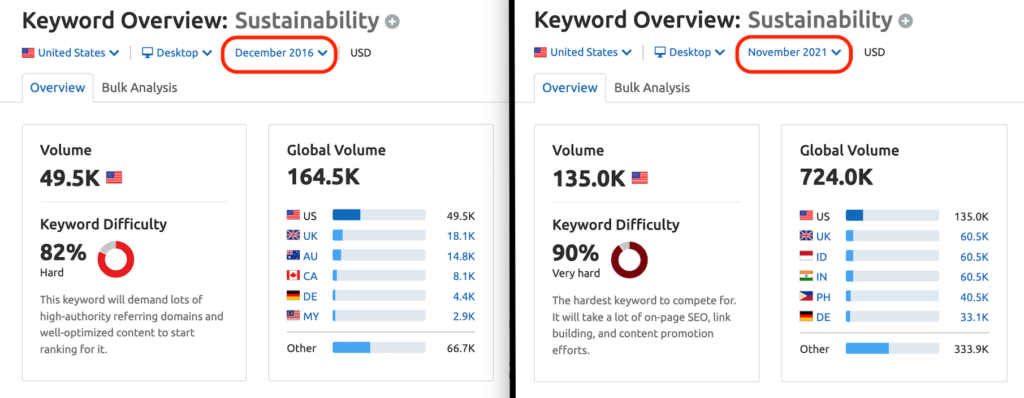
Many brands are shifting away from plastics, particularly in packaging. Other companies have begun to include information about the origins of materials and how to recycle them in their products.
Furthermore, businesses have begun to share information about their carbon footprints with customers. Mastercard, for example, has just launched a new carbon footprint calculator for banks.
These trends highlight a shift in consumer attitudes toward the environment, as well as significant opportunities for ecommerce businesses willing to embrace sustainability.
2. Reusing, Upcycling, Vintage, Second Hand…
Upcycling, vintage, and second-hand items (also known as reuse) are growing in popularity and will undoubtedly have an impact on ecommerce trends in 2022.
Businesses that specialize in secondhand items have thrived in recent years. Poshmark and Depop are two leading second-hand clothing platforms that have seen significant growth.
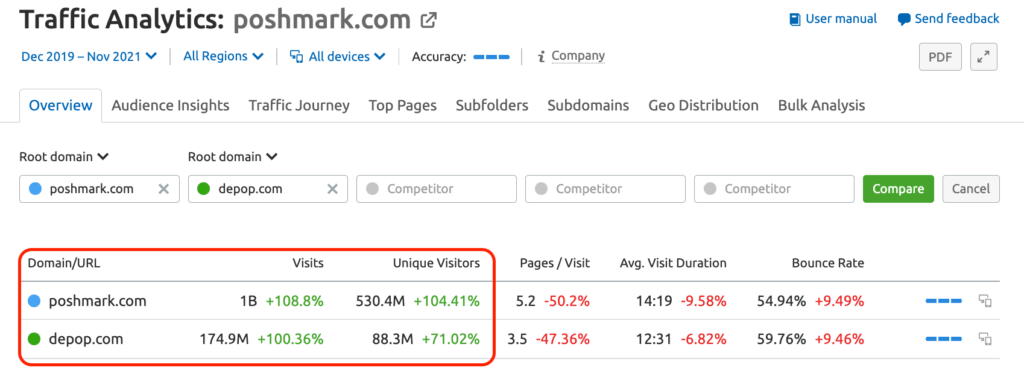
Additionally, retailers who sell new products are expanding their inventory to include used items. Zalando and Ikea already have second-hand sections, and many other companies offer recycling incentives.
Companies that specialize in electronics, such as Apple and Best Buy, also offer deals on refurbished items, giving customers more options in their shopping experience.
Ecommerce businesses can capitalize on this trend by offering similar options and appealing to customers by considering suppliers who offer upcycled products.
3. Say hello to cryptocurrency
Despite the fact that cryptocurrencies have always been presented as a viable alternative to banks and fiat currency, issues such as volatility and ease of use have slowed their adoption. Having said that, it appears that the tides are changing.
Top cryptocurrency websites and trading platforms have seen massive traffic increases in recent years. In fact, the top three in the industry will have more than tripled their traffic in 2021.
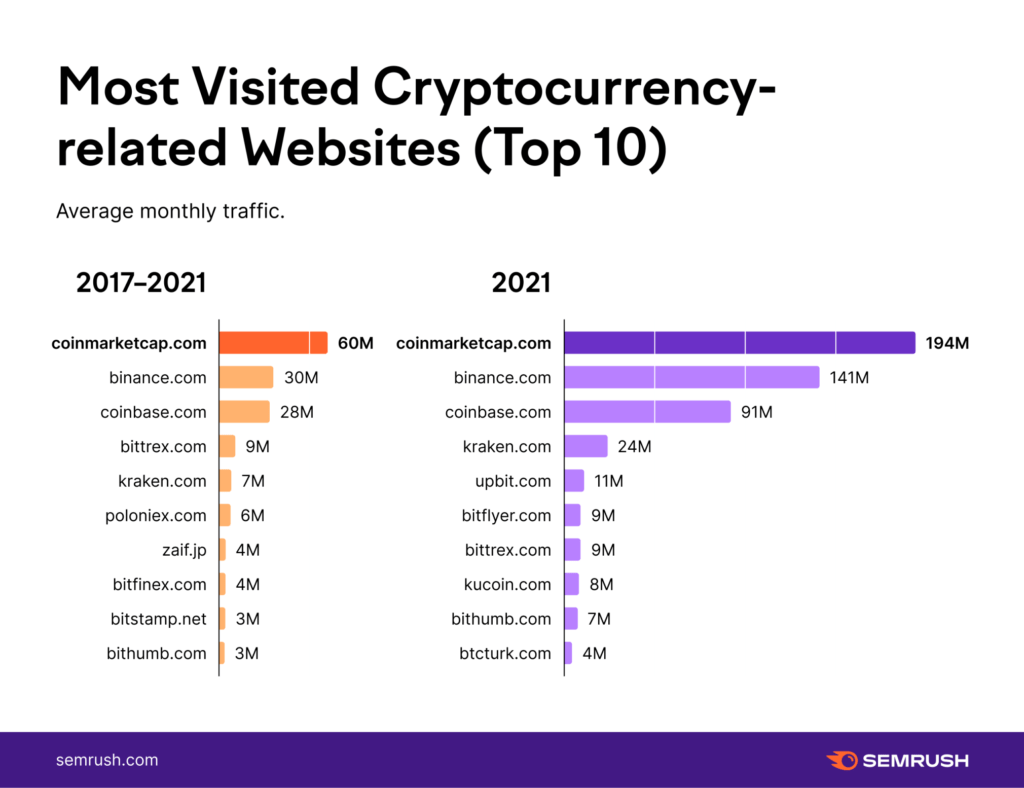
The rise of decentralized finance is already having an impact on a wide range of markets. Even large banks and payment platforms, such as PayPal and Visa, have begun to include cryptocurrencies in their product offerings.
Similarly, many governments are developing their own cryptocurrencies, while others, such as the Salvadoran government, have already accepted them as official payment methods.
However, blockchain technology, on which cryptocurrencies are based, has far more utility in ecommerce than serving as a currency exchange. Transactions made through the block chain, for example, are recorded permanently and immutably, demonstrating the journey of a product in the supply chain and, as a result, providing buyers with greater confidence.
Those interested in ecommerce should become acquainted with blockchain and cryptocurrency technology in order to stay ahead of the curve as these technologies become more mainstream.
4. The Delivery Revolution Will Not End Here
The home delivery service is evolving at a rapid pace. Companies have risen to the occasion since the beginning of the pandemic to meet consumer demand for fast and convenient doorstep delivery, but efforts are still not meeting consumer desires.
Younger generations–millennials and Gen Z–are driving demand for more flexible and faster delivery times, and businesses are adapting to meet their demands. For example, same-day delivery options are growing as a result of collaborations between delivery services and retailers, such as the recent Ulta Beauty and Doordash partnership.
Labor is a major impediment to more personalized delivery options. Working conditions for delivery and logistics workers are frequently low-paying and unsatisfactory. With the pandemic’s ever-changing state, there is more supply than demand for these jobs.
Despite these challenges, the delivery industry is expanding rapidly. Take, for example, food delivery services such as Doordash, Ubereats, and Grubhub. While these companies have been steadily growing since 2017, take note of the massive gains that have been maintained since April of 2020.
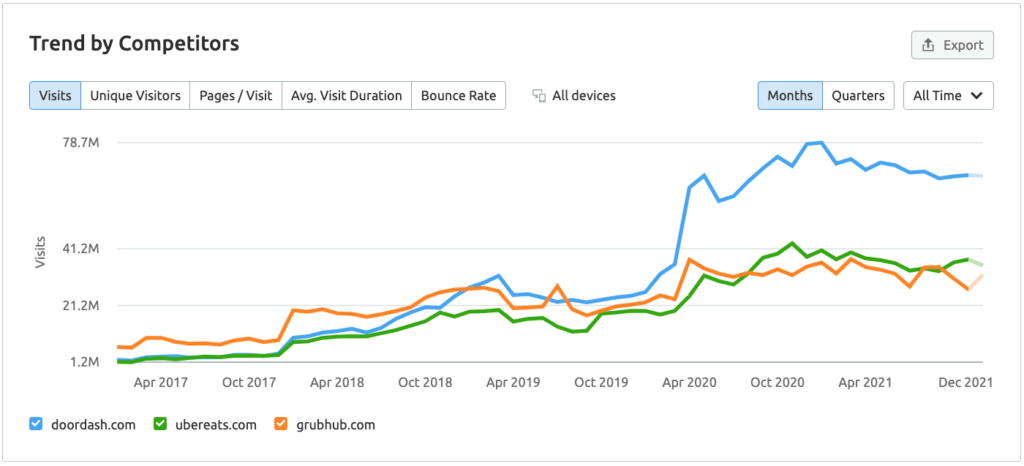
Super-optimized supply chains, multilayer distribution, and software-assisted delivery are already changing the game in home delivery, and these are trends to watch in 2022.
5. Hello and welcome to D2C Direct Sales (a Millennial Love Affair)
With the advancement of ecommerce, businesses can now afford the luxury of selling directly to consumers, eliminating the need for a large number of resellers and intermediaries. This is referred to as D2C trade, or “direct to consumer.”
Over the last five years, the concept of “direct to consumer” sales has grown in popularity. With a monthly Keyword Volume of 880 in November 2017, it has quadrupled to 4.4K in November 2021.
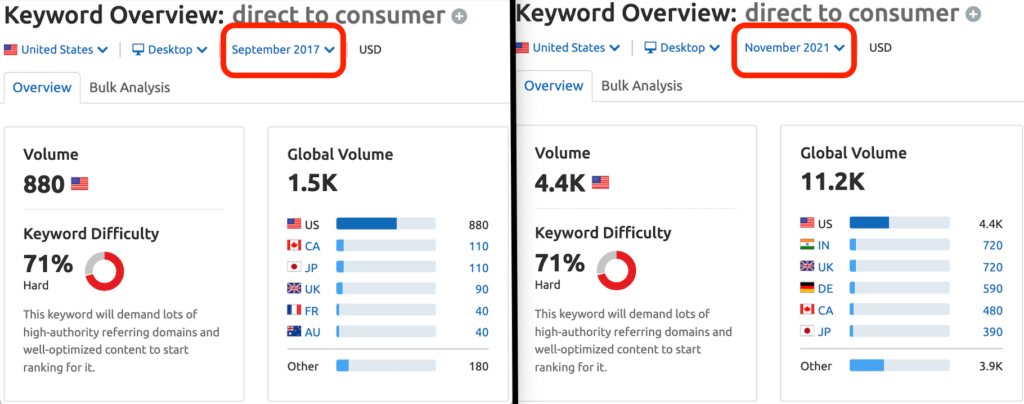
Manufacturers and large wholesalers are focusing on this type of trade due to the possibility of direct connection through online stores. In fact, big brands frequently abandon massive trading platforms like Amazon because they already have their own online store. Nike, for example, has discontinued its use of Amazon and eBay because it already has its own store.
Direct to consumer sales provide consumers with lower prices and companies with higher profits. With these factors in mind, there is no doubt that the current trend will continue into 2022.
Last Thoughts for the New Year…and Beyond
In addition to these trends, here are a few tips for growing your e-commerce business in 2022:
- Analyze the market to discover market trends. Capitalizing on some of the trends mentioned above requires first recognizing how they relate to your business and then being able to capitalize on them. Constantly researching markets and their audiences will help you develop better strategies.
- Examine the competition. To succeed in any business, you must keep a close eye on your competitors. What creative trends do they favor? What kinds of innovations are they coming up with? What are the distinguishing features? Understanding the answers to these questions will help you position your company for success.
- Keep an eye on industry news and influencers. When it comes to shifting market conditions, keep an ear to the ground for alerts from industry news sources and influencers. Maintain your competitive advantage by staying ahead of emerging trends and keeping an eye out for challenges on the horizon.
Whatever trends emerge this year, you can’t go wrong with these three recommendations. We’re excited to see where this year takes you. Here’s to a prosperous and happy 2022 for everyone!







